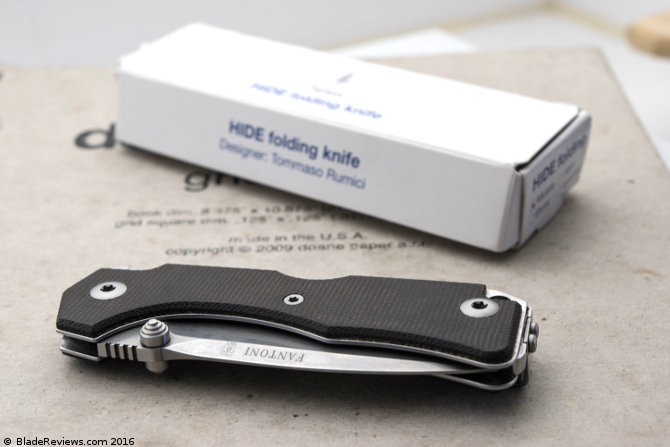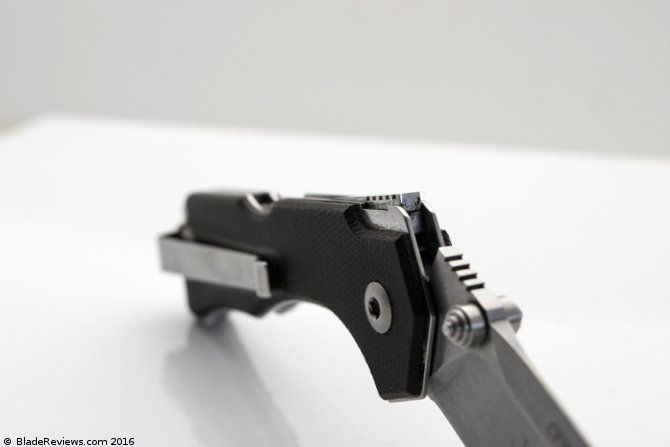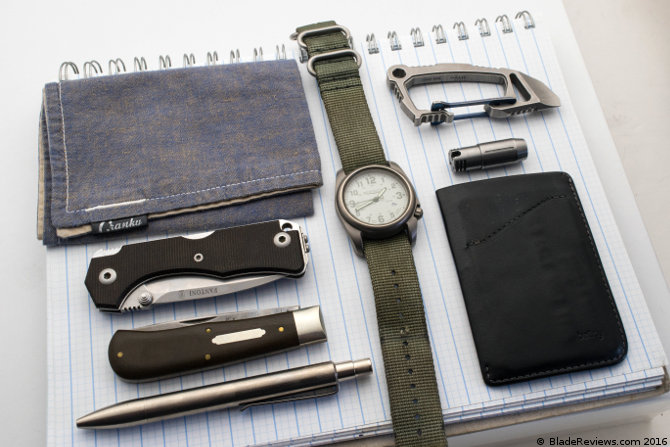This post contains affiliate links. We may get paid an affiliate commission if you buy something or take an action after clicking one of the links on this web page.
Last Updated: August 11, 2019
Author’s Note: I wrote this introduction before I saw Dan’s review of the Pohl Force Mike One. Suffice to say that Andrew Gene has long been a scourge on the wallets of knife collectors.

Buy the Fantoni Hide at KnifeArt.com
It may be hard to imagine now, but it wasn’t so long ago that Italian knife companies were a fairly unknown quantity in the United States. Back then, I was introduced to the wide world of European blades by the fantastic videos of the Edge Observer. His review of the Fantoni Hide showcased this beautiful blade to me for the first time, and it wasn’t long before I was calculating how much of my collection I’d need to part with to acquire one. As luck would have it, I didn’t need to resort to such measures.
Normally when I’m trying to explain what draws me to a product, I can point to something tangible. In the case of the Viper Dan, it was the innovative slipjoint mechanism. The Zebralight H52w grabbed my attention with stellar runtimes. That’s really not the case here. I was drawn to the Fantoni Hide simply because I liked – loved, really – the way that it looked. The interplay between the overbuilt handle and the dagger-like blade, the industrial lines and the sweeping curves; all of it combined to grant the Hide a timeless feel not unlike an Al Mar.
I should note that I never expected to write this review. The Hide fell into my hands long before I was writing for Dan, and even after I started it was a bit too esoteric for the site. Fortunately, that’s no longer the case. This sudden shift leaves me in an awkward position. Though the Hide is a grail of mine, I’ve never babied it. It shows its age. For the most part, it has aged gracefully, but after nearly two years of carry it’s taken its licks. I hope this review doesn’t shy away from those bruises, in no small part because it costs 265.00USD. That’s officially enough to qualify as an heirloom knife – at least in my book.

General Dimensions and Blade Details
The Fantoni Hide measures in at 6.89” overall, with a 2.98” blade, a 3.91” handle, is made in Italy, and designed by Italian knife designer Tommaso Rumici. It’s not chunky, but it’s not lightweight either, at 4.1 oz. The back lock and full steel liners are the culprits of most of the weight, and shift the balance to the back of the knife. Weight considerations aside, the Hide is right around the perfect size for me. My daily cutting tasks rarely require more than cutting some tape, opening a package, or slicing an apple. The Hide’s blade is long enough to do all of that without frightening a soul.

As with most Italian knives, the Hide is crafted to impeccable tolerances. The centering, perfect; the grind, immaculate. Even the hardware is polished, with the exception of the exterior bolts. Those were instead given a tasteful bead blast. The stonewash on the blade is highly polished, leaving a blade that will resist most scratches with ease. I’m a big fan of how polished this stonewash is, as it comes close enough to a mirror finish that it has some of the charm of a traditional.

The Hide’s true distinction is its refined blade. The profile is a lean drop point with the barest hint of a recurve and just enough belly to slice as well as any kitchen knife. A long swedge adds visual interest and thins out the tip for any piercing work that needs doing. The grind is similarly impressive. Not only did the craftsmen at Fantoni start with thin stock, but the hollow grind takes it down to an edge not far off from a straight razor. It goes without saying that the Hide isn’t meant for prying or other “hard use” tasks. Don’t get me wrong, it’s a tough knife. But it’s a knife, not a pry bar. Treat it as such.

I’d be lying if I said the steel was exciting. Most everyone these days is familiar with S30V, both its ups and downs. I haven’t noticed any problems with chipping or rust, and it rarely needs more than a few passes on my strop or Sharpmaker. Fantoni claims they get it up to RC60-61, and that matches my experience. Some of you may be asking if S30V is appropriate for a knife this expensive, and my answer is…kind of. In general I’d say no; but generally the heat treatment and grind aren’t nearly so dialed in as they are here. The Hide is among the elite cutters in my collection, so take that as you will.

Handle, Ergonomics, and Carry
The handle is a fairly simple affair. A steel spine is sandwiched between steel liners, which in turn is sandwiched between two slabs of green canvas micarta. There is no contouring, but the edges of the micarta have been chamfered to increase comfort. Micarta and steel are a winning recipe for me, but I understand if you think the materials are dated. If you’re that concerned, the Hide is also offered in carbon fiber and black G10, though I’ll always opt for the micarta. Not only is it the cheapest version, but a good deal of the Hide’s charm would be diminished with a sterile material like carbon fiber.

Discounting the double scallops on the interior of the handle, the Hide is comprised almost entirely of hard lines. Because of that, I assumed that the grip would (at best) be tolerable. I was pleasantly surprised to find that the ergonomics were fine; but as I expected, not without problems. First, the jimping is sharp and wide. Aesthetically pleasing, but not the most comfortable on the thumbs. Second, the pronounced finger guard keeps your fingers a fair distance away from the blade, so choking up for more control is almost impossible. I think this is just part of the genetic makeup of the Hide. It was designed to be a backup tactical knife, after all.

In the pocket, the Hide is -mostly- fantastic. The low-ride, tip up clip ensures discrete and stable carry. In my experience, the clip works well with most pants, but you may need to use a bit of force if you’re wearing thicker work clothes. When not in use, the slim profile helps the Hide disappear into the pocket, despite the relatively high weight. Sadly, the Hide has one flaw in this department: the thumb studs. Not only do they catch on clothing when you’re pulling the Hide out of your pocket, but they get thin enough to yank on any threads that stick out too far. It’s not a constant occurrence, but it’s happened just enough times that it bears mention.

Deployment and Lock-up
By now, I’m assuming that most of you are familiar with my viscerally apathetic sentiments towards frame locks, flippers, and every combination therein. They’re not bad, I’m just a curmudgeon. Or a hipster, depending on your definition. In either case, my love affair with the Fantoni Hide began long before flippers hit their stride, and it isn’t going anywhere now. Apart from the problems mentioned above, the thumb studs work fine. I’ve never disassembled the Hide, but a glance suggests that it runs on bronze washers. The strength of the back spring makes flicking this knife open impossible, but that’s a rare enough feature on quality back locks that I can’t complain.

The back lock isn’t particularly innovative, but it’s strong and easy to use. This iteration is one of the best. There is no play in any direction, and while the spring is quite stiff, it doesn’t make it a hassle to disengage the lock. I do find it somewhat confusing that this is advertised as a back-up knife. When the lock engages, it does so with an audible clack; I’d imagine that sound would make it quite difficult to hide. Ultimately, I can’t sell either the thumb studs or the back lock to those of you who hate such features. If you don’t mind them, you won’t be disappointed.

Fantoni Hide Review – Final Thoughts
If I had my druthers, I would have reviewed the Hide before I reviewed the Dan 2. Such an approach would highlight the evolution of Rumici’s talents as a designer, but wouldn’t paint the Hide in a negative light. To take that approach in the reverse, however, would end up making the Fantoni look quite brutish. Slab handles, or contoured? Proud liners, or nested? Thumb studs, or front flipper? Even I (unrepentant snob that I am) have to admit that the Dan is an improvement in most areas.
But the thing is….I own both. I carry both – frequently, in fact. Despite the fact that I have access to what is, objectively speaking, an upgraded model, the Hide gets as much if not more pocket time than the Dan 2. My best guess for this phenomenon is that while the Dan has a much more elegant design, the Hide feels more refined. Maybe I just need to carry the Dan for a few more years. At any rate, I think it says quite a bit about the quality of the Hide that it has stayed in my collection this long, with no signs of leaving.
So who should buy this knife, assuming that you can find one? If, like me, you’re a grump who thinks flippers are overhyped and frame locks passe, or if you long for the days of thin, slicy grinds, this knife is for you. Collectors of smaller, boutique Italian knives should likewise have their ears to the ground. Finally, if I’ve afflicted one of you with a similar lust for the Fantoni Hide, my apologies–but this knife is definitely for you.
I would recommend buying the Hide at KnifeArt, as they are Fantoni’s only US dealer. As usual, availability and selection is spotty, as Fantoni does not make many knives. You may be also able to find the Hide on the secondary market or places like Amazon or BladeHQ. Thanks for reading.

Is this knife actually in your rotation? What do you think about a long term use?
Hey Cesare,
Thanks for taking the time to comment.
Yes, the Hide is still in the rotation. At this point, it’s been in my collection for nearly 4 years, and my opinion hasn’t changed from what I wrote above.
Kind Regards,
Grayson
Hi Gary, i’ve write to you because i’ve find an hide folder model and i’m considering if it can be a good aquisition in my edc rotation. may postpone the purchase of the fox tur model , another good edc knife model.